Blogs
Food for Thought: Do Agricultural Innovations Improve Our Health?
Tue, 09/24/2013 - 17:28 — Vince Canger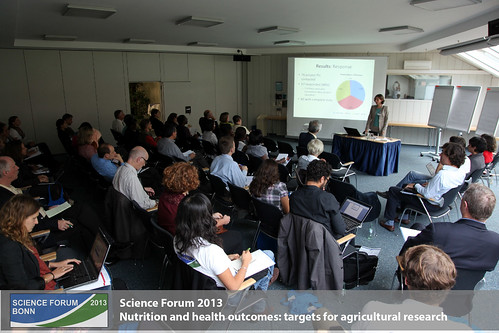 The Science Forum 2013 in Bonn, Germany, Discusses the Links between Agriculture and Health and how they can be Improved
Imagine for a moment that you're a small-scale farmer from a poor region and you grow a number of crops. Some of the crops you sell for cash which you probably use to purchase other foods you don't grow yourself, or to pay for other family expenses. The food you don't sell, you eat. But you later decide to start growing a high-yielding cotton variety with a good market demand. Your new choice in crop brings you greater income which you then use to purchase a wider range of healthier, more nutritious foods that you may not have had access to before. Such a scenario makes sense, unless you consider the contradicting evidence currently coming from research in China. (read more)
The Science Forum 2013 in Bonn, Germany, Discusses the Links between Agriculture and Health and how they can be Improved
Imagine for a moment that you're a small-scale farmer from a poor region and you grow a number of crops. Some of the crops you sell for cash which you probably use to purchase other foods you don't grow yourself, or to pay for other family expenses. The food you don't sell, you eat. But you later decide to start growing a high-yielding cotton variety with a good market demand. Your new choice in crop brings you greater income which you then use to purchase a wider range of healthier, more nutritious foods that you may not have had access to before. Such a scenario makes sense, unless you consider the contradicting evidence currently coming from research in China. (read more)
Facts and Figures: Did you know that cooking loses the beta carotene in food?
Tue, 09/24/2013 - 11:07 — Minette Flora M...
The study conducted by Inge Brouwer of Wageningen University confirms that beta carotene retention in raw food is higher than in cooked food. She took the example of sukuma wiki, a wild plant that is native in Kenya. During 28 hours of storage, the Beta carotene content of cooked sukuma wiki decreases from about 2.8 mg/100g to 1.6, while in raw food it slows down from 3.5 mg/100g to 2.1. One of the knowledge gaps she raised is how food composition tables especially for processed food can be improved.
 Inge Brouwer
This study of sukuma wiki came about with the question of “Can local diets fulfill all nutrient requirements?” This is under the assumption that diet diversity, using locally available, acceptable and affordable food, can fulfill the energy and micro-nutrient needs of people. She concluded that apart from sukuma wiki which is already explored, improvement of diets with locally available food may not fulfill all the nutrient requirements such as iron, calcium and zinc. She cautioned that more information is needed before promoting them.
If you want to learn more about how to identify the nutrients people obtain from their local diets, you can visit this website (http://www.fantaproject.org/tools/optifood).
Inge Brouwer
This study of sukuma wiki came about with the question of “Can local diets fulfill all nutrient requirements?” This is under the assumption that diet diversity, using locally available, acceptable and affordable food, can fulfill the energy and micro-nutrient needs of people. She concluded that apart from sukuma wiki which is already explored, improvement of diets with locally available food may not fulfill all the nutrient requirements such as iron, calcium and zinc. She cautioned that more information is needed before promoting them.
If you want to learn more about how to identify the nutrients people obtain from their local diets, you can visit this website (http://www.fantaproject.org/tools/optifood).
 Inge Brouwer
This study of sukuma wiki came about with the question of “Can local diets fulfill all nutrient requirements?” This is under the assumption that diet diversity, using locally available, acceptable and affordable food, can fulfill the energy and micro-nutrient needs of people. She concluded that apart from sukuma wiki which is already explored, improvement of diets with locally available food may not fulfill all the nutrient requirements such as iron, calcium and zinc. She cautioned that more information is needed before promoting them.
If you want to learn more about how to identify the nutrients people obtain from their local diets, you can visit this website (http://www.fantaproject.org/tools/optifood).
Inge Brouwer
This study of sukuma wiki came about with the question of “Can local diets fulfill all nutrient requirements?” This is under the assumption that diet diversity, using locally available, acceptable and affordable food, can fulfill the energy and micro-nutrient needs of people. She concluded that apart from sukuma wiki which is already explored, improvement of diets with locally available food may not fulfill all the nutrient requirements such as iron, calcium and zinc. She cautioned that more information is needed before promoting them.
If you want to learn more about how to identify the nutrients people obtain from their local diets, you can visit this website (http://www.fantaproject.org/tools/optifood).
Agroforestry and fruit diversity enhance food and nutrition security
Tue, 09/24/2013 - 09:38 — Louisa Wong
During the first day of the Science Forum, we have 2 sessions of “knowledge share fair” for scientists to present and discuss their studies in digital format and a cozy setting with morning coffee and hot buns served. When I came into the room, there were already a few people crowded in front of a “poster”. Katja Kehlenbeck works for ICRAF- Would Agroforestry Centre in their Nairobi office in Kenya, and she was telling us how their newly developed model “Fruit tree portfolios” can identify local specific fruit tree sets, which help the Kenyan farmers to reintroduce fruit trees into their farms according to seedling availability and seasons.
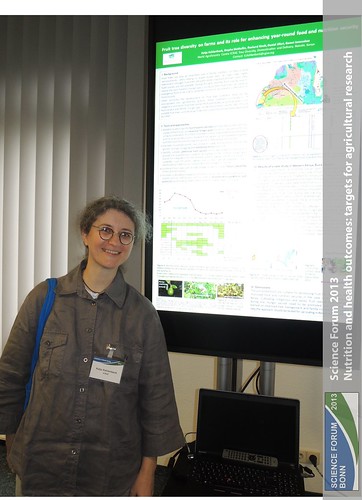 Katja was presenting in the knowledge share fair during SF 2013
Katja was presenting in the knowledge share fair during SF 2013
 Katja was presenting in the knowledge share fair during SF 2013
Katja was presenting in the knowledge share fair during SF 2013
NSA at Tropentag 2013
Tue, 09/24/2013 - 09:19 — Eva Hilt
The oral presentation session “Food consumption, consumer preference and human health” hold rich reminders why agricultural research should not only focus on food production, but always need to keep an eye on the consumption side. Under the order of NSA, Hannah Jaenicke presented a holistic framework on how to narrow the gap between the already quantitatively sufficient supply of nutrients and a qualitatively balanced diet. Even though, this does not relate to the latest scandals from the US, her transatlantic observations for example included the fact even within one household some members are obese while others are undernourished.
The motion for lunch is rejected
Mon, 09/23/2013 - 14:31 — Philipp Gassner
‘The motion for lunch is rejected’, ruled Joachim Von Braun of the University of Bonn wittily, when chairing the first plenary session at the Science Forum 2013. He rather carried on with the session, setting the scene of the Forum and pointing out, why sufficient lunch is also still rejected to 925 million people world wide. To answer why 15% of the world’s population suffer from undernourishment after decades of agricultural research is indeed a tough one. The vast amount of knowledge gathered during this time was obviously not enough. At the same time ‘We don’t need to know everything’, Von Braun pointed out. What we really have to know, keynote speaker Patrick Webb from Tufts University sketched - to provide everybody with the lunch they deserve.
Read more
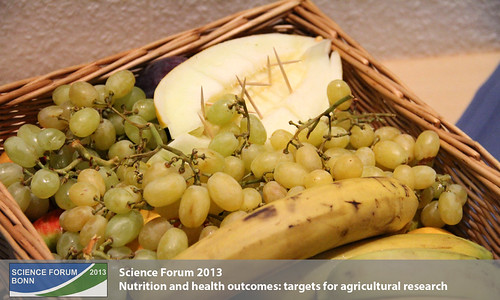 A healthy lunch @ Science Forum
A healthy lunch @ Science Forum
 A healthy lunch @ Science Forum
A healthy lunch @ Science Forum
White flies just boarded a plane to Europe!!
Sun, 09/22/2013 - 23:05 — Pamella Ogada
“Strict” Border Restrictions are not enough to curb Pests and Diseases!!
Insane as it sounds, that is the reality of things.
Pests and Diseases management has been part of scientific discussions since time immemorial with regard to agricultural production systems. With this year’s conference theme, “Agricultural development within the rural-urban continuum”, pest and diseases was not left behind, and this brought great discussion among scientist from all over the globe.
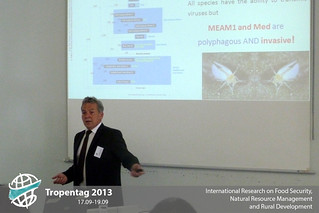 Stephan Winter Leibniz-Institute, Braunschweig, Germany
Amazing interactions between plant viruses, their vectors and their hosts plants was reported by Stephan Winter, a virologist from Leibniz-Institute, Braunschweig, Germany. According to Winter, plant viruses can travel long distance as far as United State from Africa, to Europe. This has been made possible by international trade of planting materials, vegetables and cut flowers, enabling pests and diseases of economic importance to cross strict boarders.
Generally, several driving factors have been found to contribute to this menace, scientist are committed to find solutions for the control and containment of pests and diseases.These include, cultural measures, biological control of the pest, use of tolerant crop varieties against plant diseases among others.
Stephan Winter Leibniz-Institute, Braunschweig, Germany
Amazing interactions between plant viruses, their vectors and their hosts plants was reported by Stephan Winter, a virologist from Leibniz-Institute, Braunschweig, Germany. According to Winter, plant viruses can travel long distance as far as United State from Africa, to Europe. This has been made possible by international trade of planting materials, vegetables and cut flowers, enabling pests and diseases of economic importance to cross strict boarders.
Generally, several driving factors have been found to contribute to this menace, scientist are committed to find solutions for the control and containment of pests and diseases.These include, cultural measures, biological control of the pest, use of tolerant crop varieties against plant diseases among others.
 Stephan Winter Leibniz-Institute, Braunschweig, Germany
Amazing interactions between plant viruses, their vectors and their hosts plants was reported by Stephan Winter, a virologist from Leibniz-Institute, Braunschweig, Germany. According to Winter, plant viruses can travel long distance as far as United State from Africa, to Europe. This has been made possible by international trade of planting materials, vegetables and cut flowers, enabling pests and diseases of economic importance to cross strict boarders.
Generally, several driving factors have been found to contribute to this menace, scientist are committed to find solutions for the control and containment of pests and diseases.These include, cultural measures, biological control of the pest, use of tolerant crop varieties against plant diseases among others.
Stephan Winter Leibniz-Institute, Braunschweig, Germany
Amazing interactions between plant viruses, their vectors and their hosts plants was reported by Stephan Winter, a virologist from Leibniz-Institute, Braunschweig, Germany. According to Winter, plant viruses can travel long distance as far as United State from Africa, to Europe. This has been made possible by international trade of planting materials, vegetables and cut flowers, enabling pests and diseases of economic importance to cross strict boarders.
Generally, several driving factors have been found to contribute to this menace, scientist are committed to find solutions for the control and containment of pests and diseases.These include, cultural measures, biological control of the pest, use of tolerant crop varieties against plant diseases among others.
No stress! How overwhelming conservational concerns can harm socio-economic factor.
Sat, 09/21/2013 - 15:42 — Vitalii Korol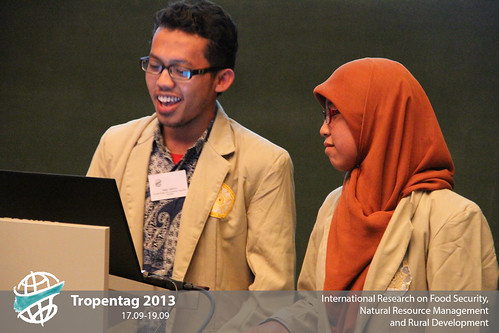 In the oral presentation session Resources within the Rural-Urban Continuum number of researchers prove that overwhelming concern about natural area and biodiversity protection can cause economic and social problems: agroforestry in Indonesia is more beneficial, than solely forest; use of wetlands for crop production in East Africa does not harm plant diversity; partial replacement of mangrove forest in Myanmar with rice farms is economically more viable, than forest alone; pastures in Caucasus Region are prioritized higher, than National Parks. see more
In the oral presentation session Resources within the Rural-Urban Continuum number of researchers prove that overwhelming concern about natural area and biodiversity protection can cause economic and social problems: agroforestry in Indonesia is more beneficial, than solely forest; use of wetlands for crop production in East Africa does not harm plant diversity; partial replacement of mangrove forest in Myanmar with rice farms is economically more viable, than forest alone; pastures in Caucasus Region are prioritized higher, than National Parks. see more
Could you live without coffee?
Sat, 09/21/2013 - 14:34 — Paulina Campos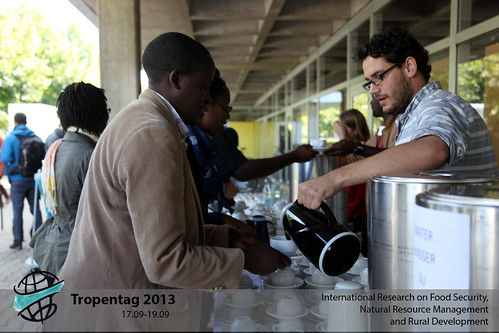 I personally would have a very hard time but still would be able to survive. But many smallholder coffee producers in San Juan del Río Coco in Northern Nicaragua would be left without their main and only source of income if they were not able to grow coffee anymore. Even if this scenario might turn into a reality in a year as far as 2050 the possibility is real and the chances quite big.
I personally would have a very hard time but still would be able to survive. But many smallholder coffee producers in San Juan del Río Coco in Northern Nicaragua would be left without their main and only source of income if they were not able to grow coffee anymore. Even if this scenario might turn into a reality in a year as far as 2050 the possibility is real and the chances quite big.




